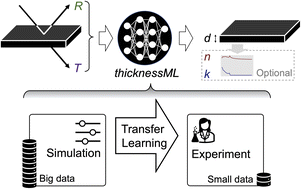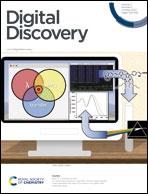Tackling data scarcity with transfer learning: a case study of thickness characterization from optical spectra of perovskite thin films†
Abstract
Transfer learning (TL) increasingly becomes an important tool in handling data scarcity, especially when applying machine learning (ML) to novel materials science problems. In autonomous workflows to optimize optoelectronic thin films, high-throughput thickness characterization is often required as a downstream process. To surmount data scarcity and enable high-throughput thickness characterization, we propose a transfer learning workflow centering an ML model called thicknessML that predicts thickness from UV-Vis spectrophotometry. We demonstrate the transfer learning workflow from a generic source domain (of materials with various bandgaps) to a specific target domain (of perovskite materials), where the target-domain data are from just 18 refractive indices from the literature. While featuring perovskite materials in this study, the target domain easily extends to other material classes with a few corresponding literature refractive indices. With accuracy defined as being within-10%, the accuracy rate of perovskite thickness prediction reaches 92.2 ± 3.6% (mean ± standard deviation) with TL compared to 81.8 ± 11.7% without. As an experimental validation, thicknessML with TL yields a 10.5% mean absolute percentage error (MAPE) for six deposited perovskite films.



 Please wait while we load your content...
Please wait while we load your content...